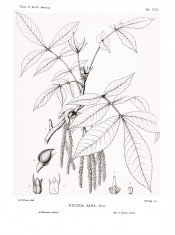Carya tomentosa Nutt.
Fully hardy tree with pinnate leaves with up to 9 oblong leaflets, nearly round, edible nuts. To 28m. [RHSE, Hortus].
Horticultural & Botanical History
‘Hicoria alba is distributed from southern Ontario southward to Cape Canaveral and the shores of Tampa Bay in Florida, and westward to Missouri, eastern Kansas and the Indian Territory, and the valley of the Brazos River in Texas. Comparatively rare at the north, where it grows on ridges and hillsides in rich soil, or less frequently on the alluvial of river-bottoms, Hicoria alba is the commonest and most generally distributed of the Hickory-trees in the south, and grows to its largest size in the basin of the lower Ohio River and in Missouri and Arkansas. It is the only Hickory found in the Pine forests of the sandy maritime Pine-belt of the southern states, where it is not rare, and with the Pignut it grows in great abundance on low sandy hummocks close to the shores of bays and estuaries along the coast of the south Atlantic and Gulf states.
The wood of Hicoria alba is heavy, very hard, strong, tough, close-grained, and flexible, with many thin obscure medullary rays and numerous large regularly distributed open ducts. It is a rich dark brown, with thick nearly white sapwood. The specific gravity of the absolutely dry wood is 0.8218, a cubic foot weighing 51.21 pounds. Confounded commercially with the wood of the Shell-bark Hickories, it is used for the same purposes.
The abundance of this species on the shores of Virginia and the other southern states probably made it known to Europeans earlier than any of the other Hickories, and it was first described by Parkinson in his Theatrum Botanicum, published in 1640.’ [Sargent – The Silva of North America vol.7, p.162, tab.CCCL/1895].
The nuts are similar to Pecans. Selected varieties will crop further north than the true Pecan, Carya olivaeformis Nutt. Introduced to Britain in 1629. [JD].
History at Camden Park
Listed in the 1845, 1850 and 1857 catalogues [T.603/1845]. Probably grown from a large consignment of tree seeds sent from North America to William Macarthur at Camden by his his brother Edward. A mature specimen survives in the Old Orchard, now part of the Elizabeth Macarthur Agricultural Institute. This may well be the original planting.
Notes
Published Mar 19, 2009 - 03:34 PM | Last updated Jul 25, 2010 - 03:23 PM
| Family | Juglandaceae |
|---|---|
| Category | |
| Region of origin | Eastern North America |
| Synonyms |
|
| Common Name | Big Bud Hickory, Mockernut |
| Name in the Camden Park Record | Juglans alba - Hickery Nut |
| Confidence level | high |


